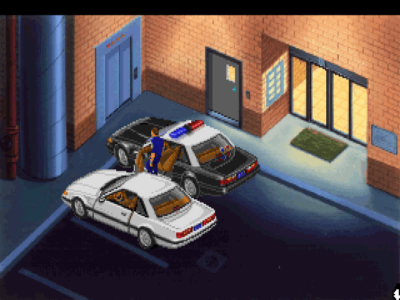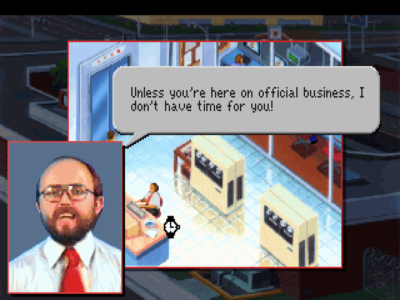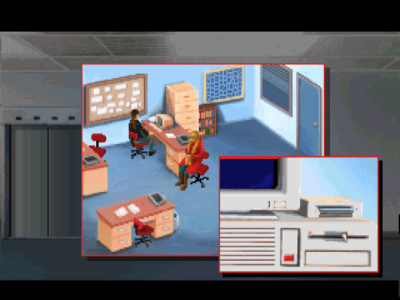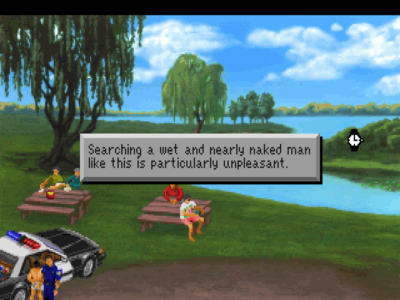
Police Quest 3: The Kindred
Written by: Rik
Date posted: February 26, 2009
- Genre: Adventure
- Developed by: Sierra
- Published by: Sierra
- Year released: 1991
- Our score: 6
Whatever words you might use to describe Sierra’s Police Quest series, “cool” certainly wouldn’t be one of them. Though the world of television and film is awash with action-packed tales of hard-drinking, gravelly-voiced cops indulging in high-speed car chases and climactic shoot-outs, Police Quest has always been more about presenting a more realistic view of police work. As the manual for this game proudly proclaims:
“Being a cop is ninety-five percent boredom. Routine is the foundation of police work – routine that can include anything from sitting under a bridge with a radar gun in your hand to making a midnight trip to the emergency room with half a kid in the back of your car.”
You get the idea, although in the case of the latter of the two tasks described (which I’ve re-read a few times to try and clarify exactly what is meant by the statement ‘half a kid’ – and each time it troubles me a little bit more) I’m pretty sure ‘boredom’ isn’t what I’d be feeling on that journey. While the earlier games were quite good at hammering home the point that being a cop isn’t exactly like what you might have seen on TV, playing them was at times a bit like watching a fire safety video or attending a neighbourhood watch meeting.

Getting ready to leave good ol’ Lytton PD. Prepare for a godawful driving section (best turn the music off, too).
Luckily, by game three (and it’s worth pointing out here that the VGA remake of PQ1 that we’ve covered on this site was actually the fourth to be released, coming after this one) things loosened up a bit, and here the game’s intro welcomes you with some reasonably high-octane credits that vaguely resemble those of a TV cop show, backed – appropriately enough – by music composed by the bloke who did the theme for the enjoyably-daft 80s favourite Miami Vice, Jan Hammer. It all seems quite slick – that is until you’re greeted by a digitised version of designer Jim Walls, who introduces the story while adopting a worryingly uncomfortable pose that seems to be testing the limits of his tight-fitting police uniform. Thankfully, you don’t have to see too much of Jim’s crotch throughout the game; he only appears intermittently to tell parts of the story, and (as in previous games) to chastise you when you’ve done something wrong. Still, I think I preferred it when it was just a badly drawn picture of his head and a couple of lines of text.
Anyway, the game continues to follow the adventures of loveably-bland small-time cop Sonny Bonds as he seeks to clean up the streets of Lytton. However, as Jim’s badly-animated head explains, the town is no longer the small and peaceful one it once was. New industry, development and growth have come to Lytton, and while on the one hand that’s a good thing (at least, according to Jim it is), it also means that there are more lowlife scumbags out there that need to be put away. Which is probably why the police station has gone from being a small hut with space for a couple of cars at the front to a three-storey behemoth in the space of three years. As implausible as it all seems, it’s a decent device for giving the series a grittier feel, and the initial animated sequence of your squad car entering the station while some moody Law and Order-style music plays in the background does a good job of setting the tone of the game.
Equally unlikely is Bonds’ role at Lytton PD, which sees him start the game as the Sergeant in charge of the traffic division, before moving to homicide later on. According to Bonds himself, homicide is his department, but apparently “they’re always short in traffic” – which presumably means that most of the baddies inhabiting the newer, grittier Lytton are doing so by driving at 65mph rather than a-robbin’ and a-stabbin’. And, while we’re mentioning the questionable plot-points, there’s also the bit where you dish out a bollocking to a mouthy subordinate early on, only to have her turn up as your new partner once you get back to the homicide department. How, exactly, did she get that promotion?

There is a suspicion that one or two or the guys from the office were drafted into the digitised cast.
What this means in game terms is that Police Quest 3 mixes the traffic duty of the first game with the murder-investigation stylings of second. However contrived the setup might be, there’s no doubting that a bit of variety is certainly a good thing. The traffic duty provides some light-hearted procedure-based capers, while the shift to homicide produces some more dramatic moments, a decent story, and the opportunity to scrape up blood from the floor and put it in a plastic bag.
Let’s deal with each of these in turn. Traffic duty involves driving around town for a bit until you see something dodgy going on. Unfortunately, ‘driving around town’ isn’t a particularly enjoyable affair, primarily because the interface that’s been designed to simulate the manipulation of a motor vehicle is significantly more taxing than actually driving a car in real life. I’m sure whoever designed it was trying to make the process quite simple and easy to use, and in a way it is: everything’s controlled via the mouse, there’s no other traffic on the road to collide with (other than when you spot a clearly-signposted ne’er-do-well getting up to no good) and you’re given plenty of warning of any junctions and turns. In practice, though, it just doesn’t work very well: the clumsiness of it all means that it’s just too easy to make mistakes, and while crashing is fairly easy to avoid, I lost count of the number of times I took a wrong turn.
In fairness, navigating the town isn’t so much an issue during the traffic duty section, because you’re not trying to get anywhere, per se, only killing time until the next bit of excitement. In fact, if I had complaints to make about this section, it would be about the amount of aimless driving around you have to do here, especially considering that the music during the driving sections is just about the worst you could possibly wish to accompany you during a period of time-wasting. To be frank, it’s awful, although it’s arguably more irritating when you’re also getting lost and taking an age to get to somewhere, which comes in more into play during the homicide section.
Anyway, once you actually spot a perp and slam on the siren, things get a bit more interesting. Without wanting to give away any of the game’s content, there’s only a limited number of easily-identifiable traffic offences you can really commit – so expect the usual collection of people driving too fast, too slow, or after a few too many beers. It’s actually good, light-hearted fun, although as ever there are some serious details that you need to note, such as the time and nature of the offence. While such things may seem obvious, they’re easy to forget in the heat of the moment, especially when you’re enjoying the erratic banter between Bonds and the people protesting their innocence. At the same time, it’s not procedure heavy, and a nice balance is struck between the need to pay attention and being able to enjoy the game (for more on this, see Walkthrough: License and registration, and step out of the car).
After a hard day out on the road, though, circumstances (i.e a major plot point which I won’t spoil here) mean that you’re back on the homicide team. This, arguably, is where the game proper begins, as you set about investigating a series of attacks and murders that (as ever) seem to be linked. Unlike the previous game, where there was a sense of trailing about after the murderer and looking at corpses, there’s more of a sense of an investigation going on here. You pick up evidence at the scene, log it back at base, and then cross-reference what you’ve found on the computer with crimes that have similar characteristics. As with the traffic section, you need to show some attention to detail to make sure you put everything together, keeping a manual note of case numbers as they crop up in the dialogue as there’s no way to search for them later. Again, this sounds easy until you make a mistake and you realise how much you’ve been mollycoddled by the world of modern gaming.
While we’re on the topic, one of my own mistakes actually resulted in the game breaking and refusing to go any further (my attempts to secure a search warrant caused the judge to become confused, refuse the warrant, and then have the game crash with the refusal locked on the screen while the talking animation continued, as if to emphasise the fact that I wasn’t going to get one). Frankly, it pissed me off, especially when I found the game kept crashing at the same point, and I had to retrace my steps to find out where I made the crucial mistake. As it happened, this involved going back and re-doing some of the more fiddly driving bits, which prompted much grinding of teeth and muttered swear words (muttered except for the time I took so long to get where I was supposed to be going that my partner offered to drive, at which point I shouted, “I WISH YOU F*CKING WOULD!” – because, of course, she can’t take over, the game was just laughing at my ineptitude).
Crashing aside, though, PQ3 doesn’t generally go out of its way to frustrate you, and you can generally foul up the less-essential bits of the investigation to your heart’s content, although you will lose points for doing so. The frequent deaths that used to be a hallmark are now mercifully rare, too, and usually occur only when you’re in a clearly-signposted ‘danger’ situation where guns might be involved. There’s another notorious danger-point during traffic duty, which I avoided by virtue of having read about it beforehand (although in fairness, Uncle Jim did remind me as well). But in general, you don’t feel as if the game is willing you to make mistakes and then punish you for them.
The story also seems to have received more attention this time around. The main plot is more varied than the humdrum ‘hunt for the madman’ setup previously on offer, and there’s a reasonably satisfying mix of investigation, tension and action here. There are a couple of side-plots that run alongside the main case, too, and it’s well worth pursuing them both if you want to score points and (more importantly) secure a happy ending for Sergeant Bonds.
So, Police Quest III has some definite plus points. There are, however, things I don’t like which I haven’t mentioned already. Firstly, the point and click interface may be shinier and better than the parser system it replaced, but I still find it sluggish and slightly slippery to use – it’s not always obvious how you accomplish a fairly simple task, whether you can use something straight away or you need to look at it first. It’s not a major irritant, just something that you might notice occasionally as you play through the game. A related question is exactly why some scenes are restricted to a window rather than being full-screen: there doesn’t seem to be a viable reason for this, and it makes things unnecessarily cramped and fiddly at times. Finally, although the dialogue has improved, it still falls into the ‘functional’ category, and incidental conversations are rare. I understand that it’s exactly not the point of the game to stand around chatting all day, but still, you might think there might be room for a word or two here and there rather than it being all business (the officer in the evidence room, in particular, should be sent on some kind of communication skills course).
Overall, then, Police Quest III represents a significant step forward for the series. It’s a tough call as to whether this or the VGA remake of the first game is the stronger one, but both are certainly worth a look, even for Sierra-sceptics. While underneath it all it’s the same dorky Police Quest, and there’s something about the schoolteacherly nature of proceedings that still grates, PQ3 has nevertheless managed to “cool” things up (or should that be down?) enough to make for a more-than-entertaining few days’ adventuring.




 Posts
Posts